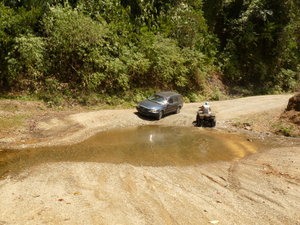Advertisement
Published: March 3rd 2011

 Driving into Bahia Drake
Driving into Bahia Drake
The road across the Osa Peninsula is the roughest yet, and with eight creeks to cross.For the last week, we have been in a small guest house in Drake Bay, on the Osa Peninsula, located on the Pacific coast of Costa Rica. To get here, most people (including locals) take the boat. However, there is a "seasonal" road (i.e. passable in the dry season which is now) and old blue Volvo plunged gamely up and down the thirty km dirt track, fording eight small rivers, to get there. She is battered and bruised but in one piece (except for some loose plastic molding around the bumpers). We have been kayaking every day with Ben from Galiano Kayaks (he spends summers on the West coast of Canada). It is idyllic.
Most days, we began kayaking around eight AM (we try to get out before it's too hot) and paddled in our group of five people down the coast a couple of km, past a stunning shoreline of rocks, sand, palm trees, parrots, pelicans, numerous other sea birds, fishing boats, and small resorts. The water is clear and tropically warm. Ben is an enthusiastic instructor so we are learning new skills in kayaking. It's fun to be able to try out new things with the anticipation that

 Checking out some obstacles
Checking out some obstacles
Road from Rincon to Bahia Drakeif you tip, it's just a pleasant splash in the warm sea. We often stop at a sandy beach to swim, or paddle up the small tidal river -- the Aguajita -- and play with the current. We swim in the river, which is slightly cooler than the ocean, so more refreshing. Then back to the village, surfing the kayaks to shore.
Most days, we return to our guest house "Casa Horizonte" by 1:30 in time for lunch. Once we had a full day of kayaking and took lunch with us. Our hostess, Jaime, is a fantastic chef and we have been eating huge amounts of fresh tropical fruit (she makes wonderful juices including star fruit juice) and fresh fish. Each morning we are joined at breakfast by parrots, macaws, capuchin monkeys who eat dates in the palm tree next to our dining room (an outdoor balcony).
We spent one day at Corcovado National Park where we saw many monkeys (including spider and squirrel monkeys), peccaries, a tapir, a salt-water crocodile, and a two-toed sloth, plus innumerable types of birds. In fact, the other couple with us are "listers" and have already seen more than 100 new species

 Casa Horizontes, Bahia Drake
Casa Horizontes, Bahia Drake
The wonderful view from the balcony where we had all our mealsof birds. On the boat ride back we saw dolphins, a sea turtle, leaping devil rays, and a humpback whale mother cradling her new baby.
We are definitely up with the sun here -- a whole orchestra starts at 5:00 AM, chirps tweets and shrill cries (TT noticed that the more beautiful the bird, the more unmusical the sound it makes). But by supper we are exhausted and start yawning at 8 PM. We made it to 10 last night before we fell into bed.
We've had wonderful weather here... sunny, quite warm but with a cooling sea breeze every afternoon. But when we have traveled through big cities, the heat is almost unbearable -- humid, sticky, stinky, energy-depleting warmth. You probably have ALL heard the famous Norwegian saying: "No such thing as poor weather, just poor clothing". True in Oslo, but not in San Jose Costa Rica. There is simply no way to dress for 35 degrees Celsius. The Bedouins cover up, the Polynesians uncover -- but they are still, I suspect, still uncomfortably hot. I think we should change the saying to "No such thing as poor weather, just poor air conditioning". KF
Saturday night

 Visitors to Casa Horizontes
Visitors to Casa Horizontes
While we were breakfasting, these white-faced capuchins came strolling along the power cord.we all went dancing at a hillside disco. Latin flavoured techno-disco-pop with a DJ who (like all DJs) does not understand the beauty of the pause between songs. Most of the dancing was done by gringos.
Yesterday, we drove off the peninsula, retracing our bumpy, wet route back to two-lane hardtop. We keep pushing the plastic bumper molding back in place and checking the tires. More new rattles and mysterious noises are emerging from the Volvo. But she keeps on rolling. Beautiful tropical cattle country out here, with tropical humped cattle and flocks of egrets. Most pastures are generously endowed with tall, tall shade trees.
We're now off the ocean and into cooler, temperate mountains. Best wishes from San Isidro de le General.
Kate and Tarjei
Advertisement
Tot: 0.144s; Tpl: 0.013s; cc: 6; qc: 45; dbt: 0.0507s; 1; m:domysql w:travelblog (10.17.0.13); sld: 1;
; mem: 1.1mb

 Driving into Bahia Drake
Driving into Bahia Drake 
 Checking out some obstacles
Checking out some obstacles
 Casa Horizontes, Bahia Drake
Casa Horizontes, Bahia Drake
 Visitors to Casa Horizontes
Visitors to Casa Horizontes


















